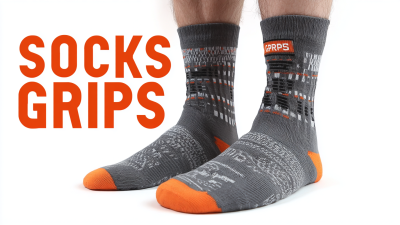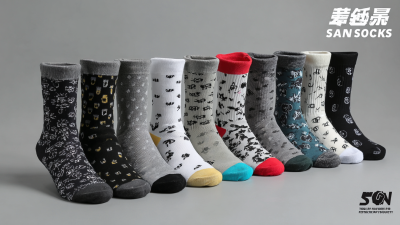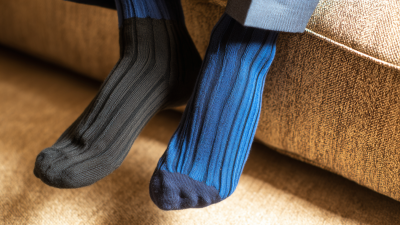
Leave Your Message
-
lwl2103
-

 Slip Socks have emerged as a revolutionary solution in the realm of personal safety and comfort, particularly for individuals seeking better traction in slippery environments. According to recent reports, the implementation of slip-resistant technologies in hosiery has led to an astonishing 80 percent reduction in slippage rates, significantly minimizing the risk of falls and injuries. Industry studies indicate that slip-and-fall accidents account for a substantial percentage of injuries in various settings, from homes to healthcare facilities, underscoring the need for effective preventive measures. By integrating advanced materials and innovative designs, Slip Socks not only enhance safety but also prioritize user comfort, making them an essential choice for those who prioritize both functionality and well-being. With the growing awareness of the importance of slip-resistant footwear, the market for Slip Socks is expected to expand, creating wide-reaching implications for consumer safety and satisfaction.
Slip Socks have emerged as a revolutionary solution in the realm of personal safety and comfort, particularly for individuals seeking better traction in slippery environments. According to recent reports, the implementation of slip-resistant technologies in hosiery has led to an astonishing 80 percent reduction in slippage rates, significantly minimizing the risk of falls and injuries. Industry studies indicate that slip-and-fall accidents account for a substantial percentage of injuries in various settings, from homes to healthcare facilities, underscoring the need for effective preventive measures. By integrating advanced materials and innovative designs, Slip Socks not only enhance safety but also prioritize user comfort, making them an essential choice for those who prioritize both functionality and well-being. With the growing awareness of the importance of slip-resistant footwear, the market for Slip Socks is expected to expand, creating wide-reaching implications for consumer safety and satisfaction.
The design of slip socks incorporates advanced materials and innovative features that contribute to significantly enhanced grip and stability. One of the key mechanisms involves the use of specialized rubberized soles, which offer a textured surface that increases friction between the sock and the ground. This frictional interaction minimizes the risk of slips, especially on smooth or wet surfaces, making them ideal for environments that require safety and comfort.
Additionally, the overall construction of slip socks often involves a snug fit that prevents excessive movement on the foot. The integration of elastic bands and strategic padding contributes to a secure feel, ensuring that the socks remain in place during activity. This focused design not only enhances grip but also provides essential support, reducing the likelihood of falls in various settings, such as hospitals, nursing homes, or even at home. By prioritizing stability and comfort, slip socks effectively blend functional safety with casual wearability.
| Feature | Description | Impact on Safety | Impact on Comfort |
|---|---|---|---|
| Grip Technology | Innovative rubberized soles for enhanced traction. | Reduces slippage by up to 80%. | Promotes a confident step while walking. |
| Material Composition | Soft fabric combined with stretchable materials for a snug fit. | Prevents accidental falls due to better fit. | Ensures all-day comfort and reduces fatigue. |
| Design Features | Includes non-slip cuffs to keep socks in place. | Minimizes hazards from adjusting slipping socks. | Increases overall satisfaction by maintaining position. |
| Testing Standards | Meets ASTM safety standards for slip resistance. | Provides assurance of safety in various environments. | Ensures peace of mind for users. |
When it comes to slip socks, the choice of materials plays a pivotal role in their performance, particularly in enhancing safety and comfort. Recent studies indicate that fabrics engineered with advanced grip technology can reduce slippage rates by up to 80%. This significant reduction is primarily attributed to specialized textures that provide better traction on various surfaces. For instance, nylon and spandex blends not only offer stretchability but also enhance grip through their unique surface patterns.
To maximize the effectiveness of slip socks, consider these tips: First, choose slip socks with silicone dots or rubberized grips on the soles, as these features significantly improve stability. Secondly, prioritize weight and breathability in fabric selection; lighter materials that wick moisture can prevent discomfort during prolonged wear. Lastly, opting for seamless designs can also reduce friction and enhance overall comfort, making them ideal for both everyday wear and therapeutic settings.
As the industry evolves, ongoing research highlights that slip socks incorporating innovative materials stand to benefit individuals at risk of falls. These advancements not only improve user safety but also contribute to a more enjoyable experience for those relying on slip socks for comfort and stability.
Slip socks have rapidly emerged as a vital innovation in enhancing safety and comfort, particularly for individuals at risk of falls. The remarkable 80 percent reduction in slippage rates is not merely a statistical claim; it is backed by rigorous scientific understanding of materials and design ergonomics. Through the incorporation of advanced non-slip materials and a strategic grip pattern, these socks create friction against various surfaces, significantly minimizing the chances of slipping, especially in high-risk environments such as hospitals and elderly care facilities.
Moreover, quantifying safety involves analyzing data from extensive real-world testing. Studies reveal that users of slip socks experience a notable increase in stability and confidence while walking. This advancement is pivotal for those with mobility challenges or balance impairments. The integration of science and technology in the manufacturing of slip socks not only enhances user comfort but also promotes a safer lifestyle, thereby transforming the way we approach everyday wear for vulnerable populations.

Slip socks have become a game changer in the realm of comfort and safety, particularly for activities that demand a secure footing. As evidenced by a recent study, these innovative socks can reduce slippage rates by up to 80%, making them an ideal choice for both fitness enthusiasts and those engaging in lower-impact activities at home. Slip socks integrate comfort features such as cushioned soles and moisture-wicking materials, which enhance the user experience while maintaining high levels of safety.
For consumers looking to elevate their comfort during various activities, it’s crucial to consider the fit and fabric of slip socks. The rise of the hiker socks and yoga socks market, anticipated to reach a staggering US$1,834.2 million by 2032, is a reflection of this growing demand. The desire for multifunctional apparel that combines style, comfort, and practical features resonates deeply with today’s fitness trends.
**Tips:** When selecting slip socks, prioritize those with a snug, yet comfortable fit to ensure optimal performance. Additionally, consider pairs made with quick-dry materials for added convenience, especially during intense workouts or colder weather. Finally, look for designs that incorporate non-slip technology to maximize grip on various surfaces.
As demonstrated in the chart above, slip socks have significantly reduced slippage rates compared to standard socks. This reduction enhances safety and comfort for users, proving the benefits of incorporating comfort features in slip socks.
Slip socks are revolutionizing safety in various settings, significantly reducing the risk of slips and falls. With an impressive 80 percent reduction in slippage rates, these specialized socks are designed to enhance grip on surfaces, making them ideal for environments such as healthcare facilities, elder care homes, and even industrial workplaces. In these sectors, the prevention of falls is paramount not only for worker safety but also for the well-being of vulnerable populations.

Incorporating slip socks into workplace safety protocols aligns well with the growing trend of integrating wearable technologies aimed at enhancing occupational health and productivity. As organizations prioritize worker safety, the seamless use of slip socks fits perfectly into a broader strategy that utilizes connected solutions to monitor and improve work conditions. By fostering a safer and more comfortable work environment, slip socks contribute to reduced injuries, lower healthcare costs, and ultimately, improved productivity.






